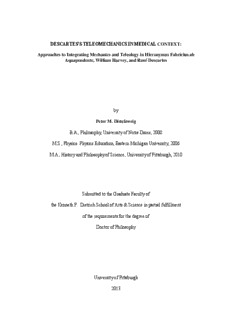
Approaches to Integrating Mechanics and Teleology in Hieronymus Fabricius ab PDF
Preview Approaches to Integrating Mechanics and Teleology in Hieronymus Fabricius ab
DESCARTES’S TELEOMECHANICS IN MEDICAL CONTEXT: Approaches to Integrating Mechanics and Teleology in Hieronymus Fabricius ab Aquapendente, William Harvey, and René Descartes by Peter M. Distelzweig B.A., Philosophy, University of Notre Dame, 2000 M.S., Physics: Physics Education, Eastern Michigan University, 2006 M.A., History and Philosophy of Science, University of Pittsburgh, 2010 Submitted to the Graduate Faculty of the Kenneth P. Dietrich School of Arts & Science in partial fulfillment of the requirements for the degree of Doctor of Philosophy University of Pittsburgh 2013 i UNIVERSITY OF PITTSBURGH The Kenneth P. Dietrich School of Arts & Sciences This dissertation was presented by Peter M. Distelzweig It was defended on August 30, 2013 and approved by Domenico Bertoloni Meli, Professor of History and Philosophy of Science, Indiana University Daniel Garber, Stuart Professor of Philosophy, Princeton University Paolo Palmieri, Associate Professor of History and Philosophy of Science, University of Pittsburgh Dissertation Co-Advisors: James Lennox, Professor of History and Philosophy of Science, University of Pittsburgh Peter Machamer, Professor of History and Philosophy of Science, University of Pittsburgh ii Copyright © by Peter M. Distelzweig 2013 iii Descartes’s Teleomechanics in Medical Context: Approaches to Integrating Mechanics and Teleology in Hieronymus Fabricius ab Aquapendente, William Harvey, and René Descartes Peter M. Distelzweig, Ph.D. University of Pittsburgh, 2013 In this dissertation, I examine the relation between mechanism and teleology in Descartes’s physiology, placing his views in a wider medical and anatomical context. I show that in this context we find distinctively Galeno-Aristotelian approaches to integrating mechanics and teleology in the work of anatomists Hieronymus Fabricius ab Aquapendente and his more famous student, William Harvey. I provide an interpretation of teleology and mechanism in Descartes by exploring the historical and conceptual relationships between his approach and those exhibited by these anatomists. First, I show that Fabricius and Harvey articulate creative, teleological, non-reductive approaches to mechanizing the animal precisely by developing Aristotelian and Galenic resources. They propose that mathematical mechanics, understood as an Aristotelian subordinate science, should be employed to articulate the way the functions of the locomotive organs explain (as final causes) certain features of their anatomy, rendering them hypothetically necessary. They articulate these explanations using the Galenic concepts actio and usus. Employing the resources developed in my analysis of Fabricius and Harvey, I then provide a new interpretation of the relation of mechanism and teleology in Descartes and clarify its significance. Although he explicitly rejects final causes in natural philosophy, Descartes still appeals in physiology to apparently teleological concepts like functio and usus. By focusing on iv the medical context of these concepts, I show that Descartes intends to and primarily does employ these concepts in mechanical explanations. Descartes’ explanations are meant to replace the metaphysically more extravagant but still material-efficient (not final-causal) explanations present in the medical tradition. I then argue that Descartes at times does in fact employ final- causal explanations similar to those in Fabricius’s and Harvey’s work. However, Descartes is hard-pressed to ground these explanations while still rejecting both divine purposes and non- mechanical principles in natural philosophy. v For CRD, a rose to this thistle. vi TABLE OF CONTENTS PREFACE ................................................................................................................................. XIV 1.0 INTRODUCTION................................................................................................................ 1 1.1 DESCARTES AND MEDICINE ................................................................................... 4 1.2 DESCARTES, HARVEY, AND FABRICIUS .............................................................. 6 2.0 MECHANICS AND THE QUAESTIONES MECHANICAE ........................................ 11 2.1 MATHEMATICS AND DEMONSTRATIVE SCIENCE IN ARISTOTLE .............. 15 2.2 THE MORE NATURAL OF THE MATHEMATICAL SCIENCES ......................... 20 2.3 SUBORDINATE SCIENCES AND THEIR PECULIARITIES ................................. 25 2.4 DE CAELO AND ASTRONOMY ............................................................................... 34 2.5 16TH CENTURY MECHANICS AS A SUBORDINATE SCIENCE ......................... 39 2.6 CONCLUSION ............................................................................................................ 47 3.0 FABRICIUS’S GALENO-ARISTOTELIAN TELEOMECHANICS OF MUSCLE . 48 3.1 FABRICIUS’S MECHANICS OF ANIMAL MOTION? ........................................... 51 3.2 FABRICIUS’S PHILOSOPHICAL AND EXACT ANATOMY ................................ 55 3.2.1 Studying Functional Organ Systems ............................................................... 56 3.2.2 Fabricius’s Galenic Actio and Utilitas ............................................................. 58 3.2.3 Historia, Teleology, and Aristotelian Comparative Anatomy ........................ 70 3.3 FABRICIUS’S TELEOMECHANICS OF MUSCLE ................................................. 84 vii 3.4 FABRICIUS, ARISTOTELIANISM, AND MECHANICS ........................................ 97 4.0 WILLIAM HARVEY AND HIS SKETCH FOR AN INTEGRATED TELEOMECHANICS OF MUSCLE ............................................................................ 100 4.1 QUONIAM FINIS ANATOMIAE EST… : UNDERSTANDING HARVEY’S ANATOMIA PHILOSOPHICA ................................................................................... 103 4.1.1 Defining and Dividing Anatomy ................................................................... 104 4.1.2 The Goal of Anatomia Philosophica ............................................................. 112 4.1.3 Harvey’s Comparative Method and the ‘Rule of Socrates’ ........................... 120 4.2 HARVEY’S ANATOMIA MUSCULI AND DE ARTIFICIO MECHANICA MUSCULORUM ........................................................................................................ 130 4.2.1 The Title, Structure, and Aim of the Notes ................................................... 131 4.2.2 De artificio mechanico musculorum .............................................................. 139 4.2.3 The Unity, Topic, and Title (again) of the Anatomia Musculi ...................... 149 4.3 THE DE MOTU CORDIS AND ANATOMIA PHILOSOPHICA .............................. 151 4.3.1 Final Causes and the Goal of Anatomy in the De motu cordis ..................... 152 4.3.2 Experiment and Anatomical Method in the De motu cordis ......................... 158 4.4 CONCLUSION: MECHANICS, MECHANISM, AND HARVEY’S GALENO- ARISTOTELIAN ANATOMICAL PROJECT ......................................................... 169 5.0 DESCARTES’S TELEOMECHANICS IN MEDICAL CONTEXT .......................... 181 5.1 DESCARTES’S TELEOMECHANICAL PHYSIOLOGY? ..................................... 187 5.2 TELEOLOGY, MECHANISM, AND EXPLANATION .......................................... 195 5.3 CONSEQUENCE-ETIOLOGICAL EXPLANATIONS IN DESCARTES’S PHYSIOLOGY .......................................................................................................... 198 viii 5.4 GROUNDING CONSEQUENCE-ETIOLOGICAL EXPLANATIONS .................. 203 5.5 DESCARTES’S STRATEGY AND ITS LIMITS ..................................................... 211 5.6 DESCARTES’S TWO TELEOMECHANICS IN MEDICAL CONTEXT ............... 217 6.0 CONCLUSION ................................................................................................................ 220 BIBLIOGRAPHY ..................................................................................................................... 223 ix LIST OF TABLES Table 1. Usus, Functio, and Explanation .................................................................................... 198 x
Description: